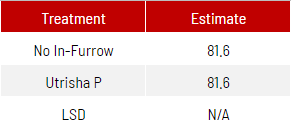2023 PAR (Product & Agronomy Research) Report: Corn Nitrogen and Utrisha® P
BY Dairyland Seed Agronomy Team
Description:
In 2023, we looked at the new biological offering Utrisha® P from Corteva Agriscience at Wabash, Ind. on corn and soybeans. The premise of this product is that it can help unlock below-ground phosphorus availability leading to improved soil exploration, plant vigor, and hopefully, improved yield potential. Utrisha P is a plant growth promoting bacteria that colonizes the root zone at soil temps above 54F during the growing season. These bacteria work to produce enzymes that can liberate phosphorous by capturing available and soil-bound phosphorus in the rhizosphere. This can lead to enhanced nutrient uptake and water availability to the plant for optimized potential in the bin.
Corn Method:
- DS-4833AM™ tested at the Wabash, Ind. location.
Corn Treatment:
- Treated with 14 oz. 6 24 6 starter fertilizer in furrow.
- Treated with 14 oz. Utrisha® P in furrow.
- Basic seed treatment nothing additional in furrow.
Corn Results:

Soybean Method:
- DSR-2562E™ planted at the Wabash, Ind. location.
Soybean Treatment:
- Utrisha® P at 14 oz
- Untreated check
Soybean Results:

Conclusion:
The drought in the early part of the season may have had some bearing on these results for this year for both crops as early vegetative stage moisture was very minimal.
Per raw data analysis of the corn trial for Utrisha® P, the simple takeaway is that there appears to be no positive or negative aspect of this product in this year.
The corn trial demonstrated that additional available nutrients, 6-24-6, improved yield and test weight, while Utrisha P had no yield benefit but was able to prop up test weight by 0.4 points when compared to the “No In-Furrow” standard. Figure that one out!
In the soybean data set, the linear model analysis used found no significant statistical difference between the two treatments.
While one year at one location did not provide any concrete positive nor negative to this product for either crop, we will repeat and refine this study for both corn and soybeans in 2024 to get a better understanding of this product’s merits.

Brian Weller
Western Region
507.456.3034

Rod Moran
Western Region
507.456.3034

Dan Ritter
Central Region
219.863.0583

Branden Furseth
Northern Region
608.513.4265

Mark Gibson
Eastern Region
260.330.8968

Amanda Goffnett
Eastern Region
989.400.3793

Ryan Mueller
Eastern Region
989.400.3793
